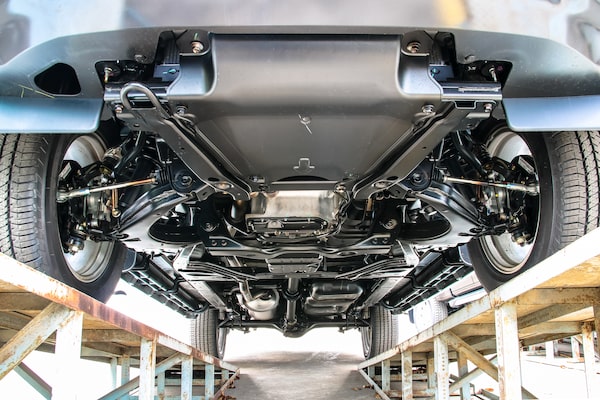
Pickup Car chassis bottom viewWachira Wacharapathom/Istock
Unlike most things that involve the surrendering of our money – hard-earned or otherwise – vehicles are one of the few commodities that have actually improved over the years.
Unlike all those electronics, refrigerators and dishwashers that routinely die within eight minutes of warranties expiring, the average recent-model vehicle is comprised of parts that are far superior to most of its predecessors.
For the most part, that’s a good thing – especially when you recall all those 1970s and ’80s cars that were pre-rusted at the plant. But when it comes to your exhaust system, the most forgotten and unappreciated part of your vehicle, there’s a downside to improvement.
Most vehicles built in the last decade or so have exhaust systems made of stainless steel. So instead of mufflers and tailpipes rusting out in four or five years like they used to, they’re often lasting the life of the car.
“We’re seeing fewer exhaust piping leaks,” says Sean Cooney-Mann of OK Tire. “But we’re also seeing more exhaust gasket leaks.”
That's because gaskets and the other hardware that connect the stainless steel components to the vehicle aren't quite as durable.
While that may seem like a fair trade-off – gaskets tend to be a lot cheaper than entire exhaust systems – most of us don’t even notice the wear and tear on smaller parts and assume all is well. But they often break down undetected, causing serious problems down the road.
And if that road is the typical pot-hole-filled obstacle course commonly found in Canadian cities, the issues will develop sooner rather than later.
Cooney-Mann says that with Canada's temperature extremes, there's a lot of contracting and expanding going on with the gaskets, connecting parts and bolts.
“Add in the jarring effect of our road conditions, and you’ve got trouble,” he says. “When your car is violently gyrating, almost like an off-road experience, it’s putting a lot of stress on any component holding (the exhaust system) together.”
Another factor contributing to exhaust issues is the catalytic converter, ironically because they, too, are built better than ever. Manufacturers have improved them greatly to filter out even more pollutants. But that means the exhaust coming out the other end is hotter than ever, Cooney-Mann says.
And that puts even more pressure on those already heavily taxed gaskets.
That means that although your car isn't doing its most full-throated NASCAR impression, your leaky exhaust system is still emitting bad stuff. For obvious reasons, you don't want a leaky exhaust because it will spew out deadly carbon monoxide fumes and possibly fill your vehicle with other noxious gases.
But it's also doing a silent number on gas mileage and engine efficiency.
“Even a minor leak can cost you up to a litre per 100 kilometres in efficiency,” says Cooney-Mann. "Also, it will cause your check-engine light to appear. When that goes on, your car goes into a default mode. It can’t monitor the engine properly, so you’re not at peak efficiency.
“The car can’t tell you at 500 rpm that it needs this much fuel and this much air ... it just gives you this much fuel no matter what. Then you’re losing efficiency and mileage.”
Since most of us can't tell a leaking gasket from a watermelon, the easiest way to prevent these problems from developing is a semi-annual inspection, which most garages will do for free.
And the best time to do it is after one of our brutal winters, which do a number on your undercarriage.
“It also makes sure you won’t have any problems in summer when the heat and the tendency to do longer trips puts more stress on a compromised system,” says Cooney-Mann.
A return visit in the fall should keep you protected through another winter.
Shopping for a new car? Check out the new Globe Drive Build and Price Tool to see the latest discounts, rebates and rates on new cars, trucks and SUVs. Click here to get your price.
Sign up for the weekly Drive newsletter, delivered to your inbox for free. Follow us on Instagram, @globedrive.